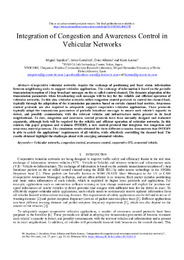Please use this identifier to cite or link to this item:
https://hdl.handle.net/11000/5101Full metadata record
| DC Field | Value | Language |
|---|---|---|
| dc.contributor.author | Sepulcre, Miguel | - |
| dc.contributor.author | Gozalvez, Javier | - |
| dc.contributor.author | Altintas, Onur | - |
| dc.contributor.author | Kremo, Haris | - |
| dc.contributor.other | Departamentos de la UMH::Ingeniería de Comunicaciones | es |
| dc.date.accessioned | 2019-04-04T09:53:54Z | - |
| dc.date.available | 2019-04-04T09:53:54Z | - |
| dc.date.created | 2015-10-09 | - |
| dc.date.issued | 2019-04-04 | - |
| dc.identifier.issn | 1570-8705 | - |
| dc.identifier.issn | 1570-8713 | - |
| dc.identifier.uri | http://hdl.handle.net/11000/5101 | - |
| dc.description.abstract | Cooperative vehicular networks require the exchange of positioning and basic status information between neighboring nodes to support vehicular applications. The exchange of information is based on the periodic transmission/reception of 1-hop broadcast messages on the so called control channel. The dynamic adaptation of the transmission parameters when broadcasting such messages will be key for the reliable and efficient operation of vehicular networks. To this aim, vehicular networks utilize congestion control protocols to control the channel load, typically through the adaptation of the transmission parameters based on certain channel load metrics. Awareness control protocols are also required to adequately support cooperative vehicular applications. These protocols typically adapt the transmission parameters of periodic broadcast messages to ensure each vehicle’s capacity to detect, and possibly communicate, with the relevant vehicles and infrastructure nodes present in its local neighborhood. To date, congestion and awareness control protocols have been normally designed and evaluated separately, although both will be required for the reliable and efficient operation of vehicular networks. In this context, this paper proposes and evaluates INTERN, a new control protocol that integrates two congestion and awareness control processes. The simulation results obtained for three different scenarios demonstrate that INTERN is able to satisfy the applications’ requirements of all vehicles, while effectively controlling the channel load. The results obtained highlight the challenges ahead with emerging automated vehicles | en |
| dc.format | application/pdf | en |
| dc.format.extent | 20 | es |
| dc.language.iso | eng | en |
| dc.rights | info:eu-repo/semantics/openAccess | en |
| dc.subject | Vehicular networks | en |
| dc.subject | congestion control | en |
| dc.subject | awareness control | en |
| dc.subject | cooperative ITS | en |
| dc.subject | connected vehicle | en |
| dc.subject.other | 621.3 - Ingeniería eléctrica. Electrotecnia. Telecomunicaciones | es |
| dc.title | Integration of Congestion and Awareness Control in Vehicular Networks | en |
| dc.type | info:eu-repo/semantics/article | en |
| dc.identifier.doi | 10.1016/j.adhoc.2015.09.010 | - |
| dc.relation.publisherversion | https://doi.org/10.1016/j.adhoc.2015.09.010 | - |

View/Open:
15-Integration of congestion and ....pdf
553,89 kB
Adobe PDF
Share:
.png)
